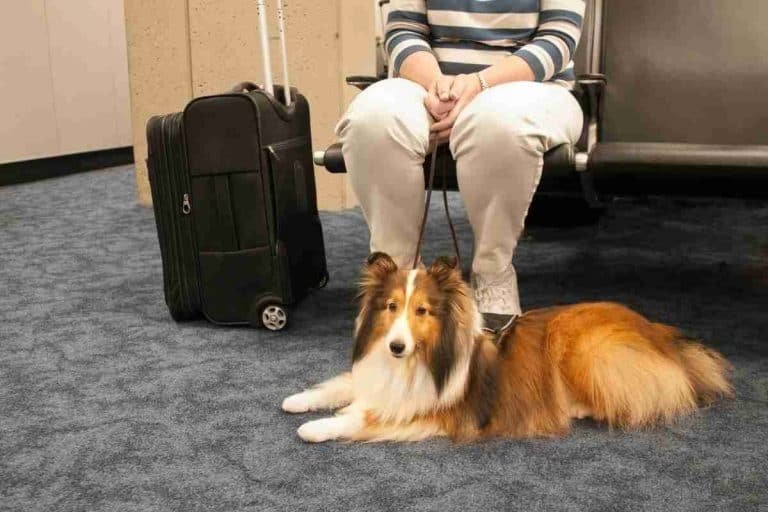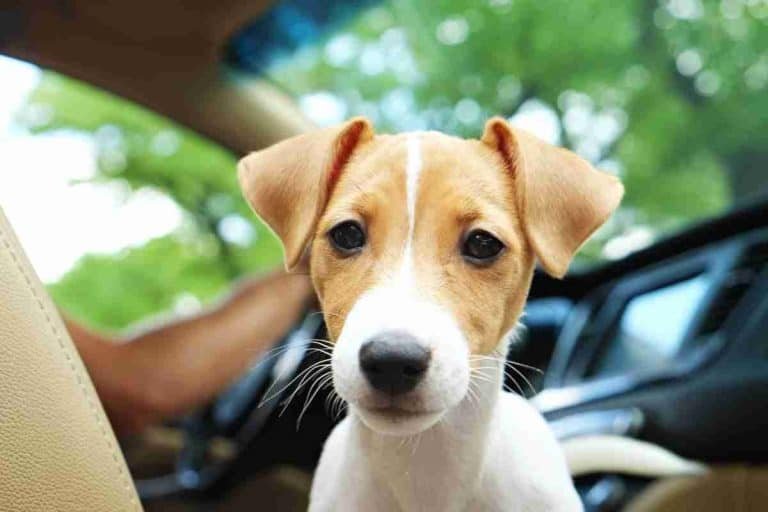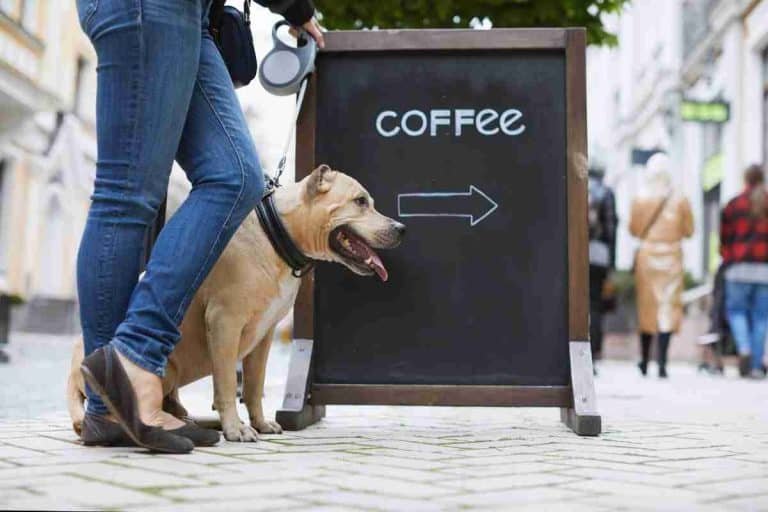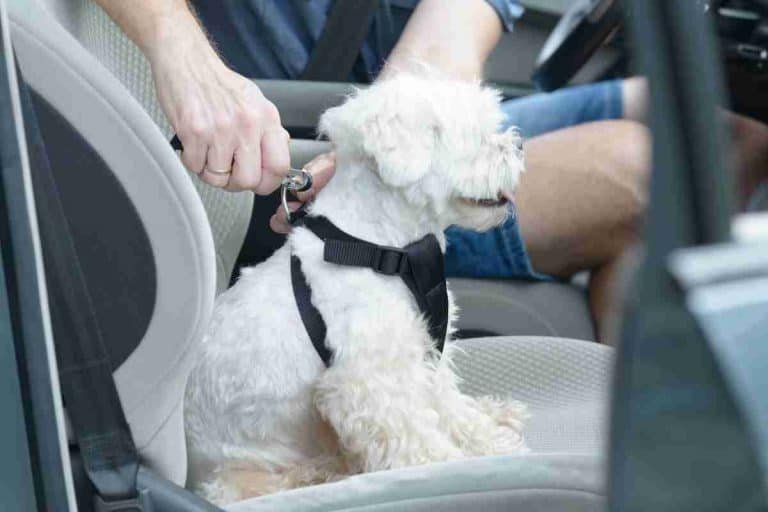Can Dogs Travel in a Car Footwell? Laws, Risks, and Safer Options
Last Updated on October 26, 2025
Can Dogs Travel in a Car Footwell? Short answer: they shouldn’t. Most laws require reasonable restraint that prevents distraction or pedal interference. The footwell sits near controls and airbag zones, making danger foreseeable. Under Rule 57-style duties, police and insurers assess that risk and may issue penalties.
This guide explains the laws, the real-world hazards, and safer options. It compares harnesses, crates, and cargo barriers, with step-by-step setups for each. Owners also get checklists, training tips, and evidence to show officers after a stop. Fewer risks, fewer fines, and a calmer ride for everyone.
What driving rules say about where dogs can sit in a car
Can Dogs Travel in a Car Footwell? Laws, Risks, and Safer Options sits at the center of how regulators and courts view animal restraint while driving. Most jurisdictions require drivers to keep control of the vehicle and not be distracted by passengers, including pets. Those broad duties translate into specific rules that say animals must not impede the driver or block controls.
Regulators rarely list every allowed location. Instead, they describe a duty to secure animals so they cannot interfere with safe driving. That leaves room for interpretation about seat, boot, crate, or footwell placement. Courts and police will assess whether the dog’s location distracted the driver or created a hazard.
Practical compliance favors restraint systems that keep a dog in one place and prevent contact with the driver. For guidance on safe travel gear and setup, see essential dog travel tips and gear for road trips. Owners should treat local guidance as minimum standards and choose restraint options that eliminate distraction.
Rule 57 and comparable regulations — the legal duty to restrain animals
Rule 57 and similar statutes focus on the driver’s duty to secure animals in a vehicle. These rules require restraint that prevents an animal from moving into the driver’s space or causing distraction. The wording often centers on “reasonable restraint” or “preventing interference with driving.”
Enforcement depends on observable risk. An unrestrained dog on a lap, between seats, or roaming counts as an avoidable distraction. A restraint can be a harness attached to a seatbelt, a secured crate, or another approved device. Law enforcement assesses whether restraint was adequate given the dog’s size and behavior.
For practical restraint methods that meet Rule 57-style duties, consult guidance like how to secure a dog in car with leash. Owners should document the restraint used after an incident, since proof of reasonable precautions can affect citations or insurance outcomes.
How laws treat the front passenger area and the footwell specifically
Legislation rarely names the footwell explicitly. Instead, statutes describe prohibited interference with driving. The front passenger area, including the footwell, counts as a zone where a dog may distract the driver or obstruct controls. Officers evaluate whether a pet sat in that space and created a hazard.
Practical issues make the footwell risky. Sudden braking can send a small dog under pedals. A dog that moves into the driver’s legs can affect steering or pedal control. Courts weigh foreseeability: if a driver routinely allows a dog in the footwell, authorities may view that as negligent.
Puppies and small dogs often travel without crates. Advice on alternatives to a footwell placement appears in how to transport a puppy in a car without a crate. Drivers should avoid the footwell and use anchoring systems that keep animals away from pedals and driver movement.
Penalties, careless-driving charges and insurance consequences
When a pet causes distraction or an incident, penalties can escalate. Police can issue fixed fines, careless-driving charges, or citations tied to animal-control laws. The charge depends on severity: a minor distraction might lead to a warning or fine. A crash linked to a roaming dog can trigger careless-driving or worse.
Insurance implications matter. If a driver’s pet caused the collision, insurers may assign partial or full fault. That decision affects premiums and future coverage. Failure to use recognized restraint methods can weaken a policyholder’s position during claims and dispute resolution.
Owners can reduce risk by using approved crates or tethering systems and documenting those measures. For concrete methods to secure crates and reduce liability, review 5 ways to secure a dog crate in car. Taking proactive steps will help in traffic stops and post-accident investigations. Owners should also check local guidance and insurer requirements before travel.
Why the footwell is a dangerous place for a dog
The footwell places a dog in a compact, high-risk area where forces concentrate during sudden stops and crashes. A dog tucked under the dash sits directly in the vehicle’s crush zone. That position exposes the animal to direct impact from the dashboard, steering column movement, and intruding components during collisions. The low ceiling and confined space also increase the chance of head, neck, and spinal injuries.
Footwells leave little room for the dog to brace or roll away, so even low-speed incidents can produce severe blunt-force trauma. Car components move unpredictably on impact; a dog in the footwell can be thrown into pedals, metal edges, or the base of the seat. That proximity also complicates rescue and first aid at the scene.
Owners who want safer travel arrangements should plan restraint and containment before every trip. Practical gear and routines reduce risk and improve compliance with many jurisdictions’ rules for animal transport. For reliable options on safer gear and packing for road trips, see essential dog travel tips and gear for road trips.
Airbag deployment and blunt-force risks to animals and passengers
Airbags deploy with high speed and force. They inflate in milliseconds to protect people. A dog in the footwell sits near the deployment zone for passenger-side airbags. When an airbag deploys, it can strike a dog’s head, neck, or chest with enough force to cause fractures, internal injuries, or fatal trauma.
An unrestrained dog can also become a projectile during deployment. The dog’s sudden movement may strike a passenger, worsening injuries for both. Airbag force can push a dog into steering or dashboard structures, amplifying blunt-force effects.
Given these hazards, never place a dog where an airbag can contact it. Use properly secured crates or approved harnesses in rear seating or cargo areas instead. For guidance on securing a crate to reduce movement and airbag interactions, consult how to secure a dog crate in a car.
Entrapment, limb injuries and lack of escape routes in crashes
The footwell’s confined geometry creates entrapment hazards that broader seating areas do not. In a crash, structural intrusion can narrow the space further. A dog can become pinned under pedal assemblies or between seat frameworks. That pressure leads to crushed limbs, severe fractures, and soft-tissue damage.
Smaller dogs may become wedged behind or under components, preventing breathing or movement. In rollovers, the footwell can trap a dog until rescuers access the cabin. Even without collision, sudden braking can force paws into tight gaps, producing sprains or nail tears.
Prevent entrapment by placing the dog in a secured crate or a properly anchored harness mounted to the vehicle’s frame. Owners transporting puppies or seniors should choose containment that allows breathing and limits forward motion. For tips on moving a dog without a crate and alternatives for small or anxious dogs, see transport a puppy in a car without a crate.
How a dog in the footwell increases driver distraction and crash severity
A dog in the footwell raises the risk of distracted driving through unexpected movement and obstruction. Animals can climb toward the driver, block pedal access, or tangle with feet during gear changes. Even brief distraction adds reaction time and can raise crash risk.
When a dog moves suddenly, drivers often react by braking or swerving. Those evasive inputs increase the chance of loss of control and secondary collisions. An unrestrained dog also interferes with proper seating posture and pedal use, which can worsen the outcome in emergency maneuvers.
To reduce distraction, secure the dog away from the driver’s compartment. Use a crash-tested harness for seat-belt attachment or a sturdy crate in the cargo area. For practical restraint methods that cut distraction and improve safety, review guidance on how to secure a dog in car with leash. Drivers should test restraint setups at low speed before long trips and keep a short checklist: crate/harness fastened, floor area clear, and water available.
Approved restraint options and their safety trade-offs
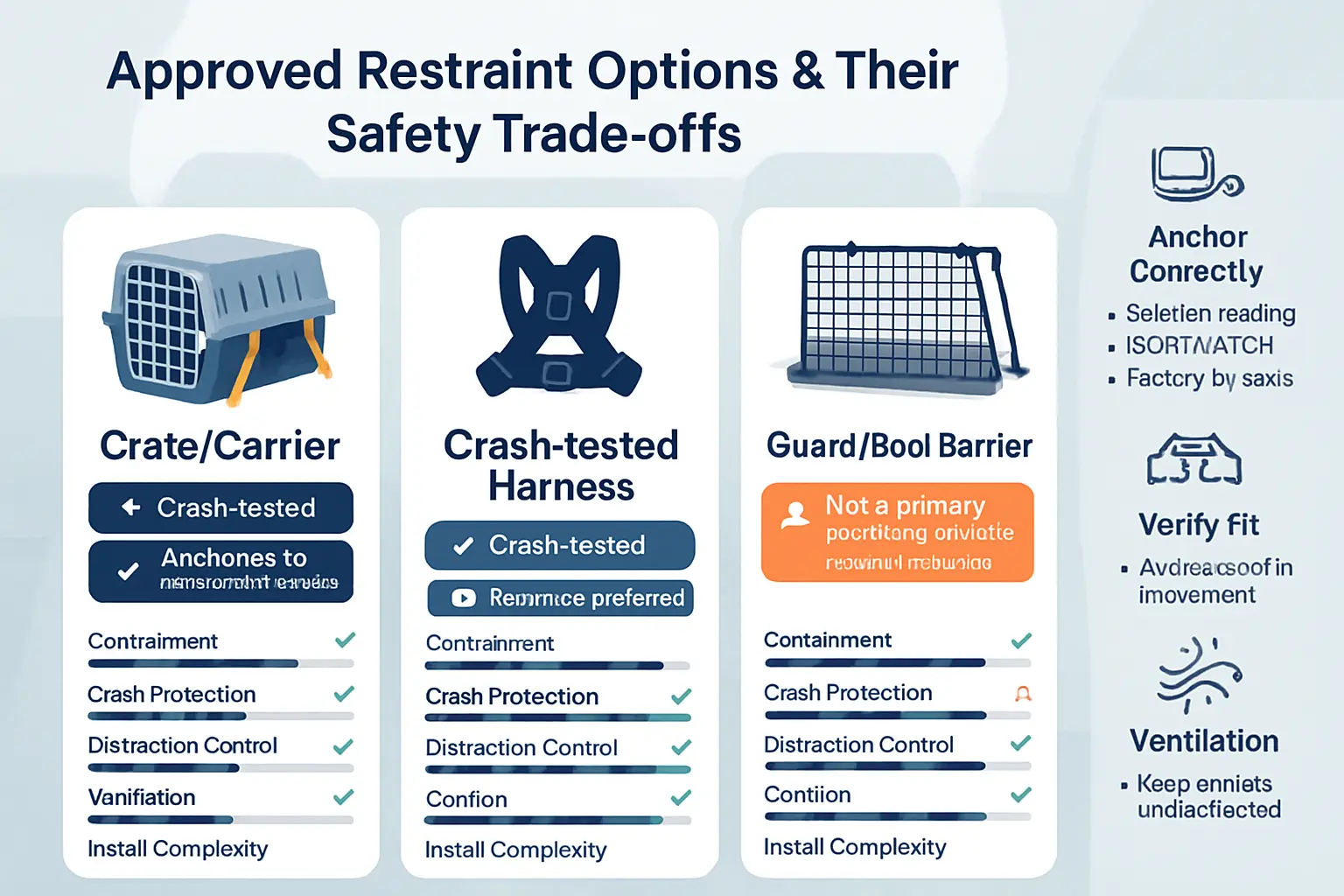
Automobile safety experts and many jurisdictions expect dogs to travel restrained. Approved options balance containment, crash protection and comfort. Each option carries trade-offs: crates confine and distribute crash forces but restrict movement; crash-tested harnesses keep dogs on the seat but may not perform equally across vehicle types; guards and boot barriers prevent cabin access but offer little crash protection alone. Owners should weigh the dog’s size, temperament and trip type when choosing a solution.
Key factors to compare include tested crash performance, how the device anchors to the vehicle, ease of emergency extraction and ventilation. For long trips, breathable containment with secure anchoring rates higher for overall animal welfare. Short errands may allow simpler restraints, but safety still requires proper fit and secure attachment. Manufacturers publish vehicle-attachment instructions; follow them. For practical guidance on securing crates inside cars, see 5 ways to secure a dog crate in car.
Crates and carriers — correct sizing, anchoring and ventilation
Choose a crate that lets the dog stand, turn and lie down comfortably. Oversized crates reduce stability during sudden stops; undersized crates cause stress and poor ventilation. Rigid plastic crates with metal doors generally perform better in crashes than soft carriers for medium to large dogs.
Anchoring matters more than appearance. Use the vehicle’s seatbelt routing, cargo-area tie-downs or purpose-fit L-brackets to prevent crate rotation. Add non-slip mats to limit sliding. Follow manufacturer instructions and test the anchored crate by applying firm manual force in multiple directions.
Ventilation must remain unobstructed. Avoid placing a crate near heater vents in hot weather and ensure airflow through multiple mesh or vent openings. For tips on physical anchoring techniques, consult the step-by-step guide at 5 ways to secure a dog crate in car.
Crash-tested travel harnesses and seatbelt attachments — pros and cons
Crash-tested harnesses designed to meet independent standards provide a good balance of mobility and protection for seat travel. Look for harnesses certified by reputable labs; they distribute forces across the chest and torso instead of the neck. Proper sizing is critical: the harness should fit snugly without restricting breathing.
Pros include easier access in an emergency and compatibility with a passenger seat. Cons include variable testing—many brands lack crash certification—and potential for poor anchoring if users attach harnesses to flimsy seat belt clips or webbing. Keep tether length short enough to prevent the dog slipping under the seat, but long enough to sit and lie down comfortably.
Always attach to a vehicle anchorage point rated for occupant restraints. For broader gear recommendations and travel tips, see essential dog travel tips and gear for road trips.
Dog guards, boot barriers and bench covers — when to use each
Dog guards and boot barriers suit dogs that ride in the cargo area of wagons or SUVs. A rigid guard that mounts to the vehicle frame reduces forward intrusion during hard braking. Use boot barriers to separate active dogs and loose cargo from the passenger area, improving driver focus.
Bench covers and hammock-style seat protectors protect upholstery and limit sliding but do not restrain a dog in a crash. Treat bench covers as a comfort and cleanliness solution only. For larger dogs that move between cargo and cabin, pair a guard with a crate or crash-tested harness to combine spatial separation with crash protection.
Installation must follow vehicle-specific instructions to ensure fit and structural engagement. For practical tips on securing dogs in cargo areas, consult how to secure a dog in the cargo area of SUV. Owners should pair barriers with tested restraints rather than rely on barriers alone.
Step-by-step: replace the footwell with safer positions and setups
Can Dogs Travel in a Car Footwell? Laws, Risks, and Safer Options guides practical replacement steps that avoid the footwell entirely.
Step 1 — choose the safer position. The safest locations usually are the rear middle seat, a secured crate on the flat cargo floor, or a properly fitted dog booster seat anchored to the vehicle. Step 2 — select the restraint type. Use a crash-tested harness clipped to the vehicle’s seatbelt or ISOFIX/LATCH anchors for small to medium dogs. For anxious or larger dogs, a sturdy travel crate bolted or strapped to the cargo area performs better.
Step 3 — prepare the car. Remove loose items, cover surfaces with non-slip mats, and set window ventilation. Step 4 — secure the dog and gear. Route the seatbelt through harness attachment points or crate fixings and tighten. Step 5 — verify. Perform a firm tug test and confirm no more than two inches of movement. Check harness clips and crate fixings after the first short trip.
For a checklist of recommended gear and placement tips, consult the essential dog travel tips and gear for road trips. Owners should consider local laws on restraint and always match restraint to the dog’s size and behavior.
Best seating/space choices by dog size and temperament
Small dogs (under 15 lbs) benefit from a secured booster or a well-anchored carrier placed on the rear seat. Boosters keep them elevated and restrained while letting them see out. Medium dogs do best with a crash-tested harness attached to the rear middle seatbelt or a low-profile crate on the floor.
Large dogs require the most space. A dedicated cargo area with a rigid partition and bolt-down crate or heavy-duty harness anchored to the vehicle frame offers the best protection. Avoid placing large dogs on seats without proper restraints; sudden stops can turn an unrestrained dog into a projectile.
Temperament matters. Anxious dogs respond better to enclosed crates that reduce sensory input. Calm, social dogs often ride safely harnessed in the rear seat. Dogs with motion sickness prefer low, stable positions on the floor or in a crate with bedding. Match the restraint to the dog’s comfort and the vehicle layout.
For crate options and sizing guidance, see the review of the best dog crates for car travel.
How to install and check anchors, harness clips and crate fixings
Begin by locating the vehicle’s anchor points. Use ISOFIX/LATCH points for compatible harnesses and crates. When anchors are absent, route a three-point seatbelt through the restraint manufacturer’s designated path.
Install harness clips so the dog sits comfortably with limited forward travel. Tighten until the harness allows two fingers between strap and body. For crates, thread ratchet straps through the crate frame and anchor them to factory tie-downs or heavy bolts. Tighten straps until the crate hardly shifts under firm hand pressure.
Perform a pull test. Push and pull the restraint assembly with force mimicking a sudden stop. Inspect clips, webbing, and anchor bolts for wear, rust, or fray. Replace any component that shows damage. Check hardware after the first trip and again monthly.
Follow step-by-step methods to secure crates in cars detailed in the guide on five ways to secure a dog crate in car. Keep tools on hand to re-tighten fittings before long drives.
Training and short practice trips to acclimate your dog
Training prepares the dog to accept a safer position and restraint. Start with the car parked. Let the dog explore the chosen spot with the harness or crate open. Reward calm behavior with treats and praise. Repeat short sessions daily until the dog approaches the area willingly.
Next, practice short rides of three to five minutes on quiet roads. Keep motion and noise minimal. Increase duration gradually, monitoring for signs of stress or nausea. If the dog panics, step back to stationary sessions and reintroduce the harness or crate slowly.
Use positive reinforcement. Offer treats, chew toys, or a familiar blanket. For dogs prone to motion sickness, try short rides before meals and consult the vet for anti-nausea options. Teach a cue like “clip in” to make restraint routine and predictable.
For behavioral tips and anxiety remedies that support acclimation, refer to nine natural ways to remedy your dog’s travel anxiety. Schedule practice trips before any long journey to build confidence and compliance.
Choosing equipment for your dog and vehicle type
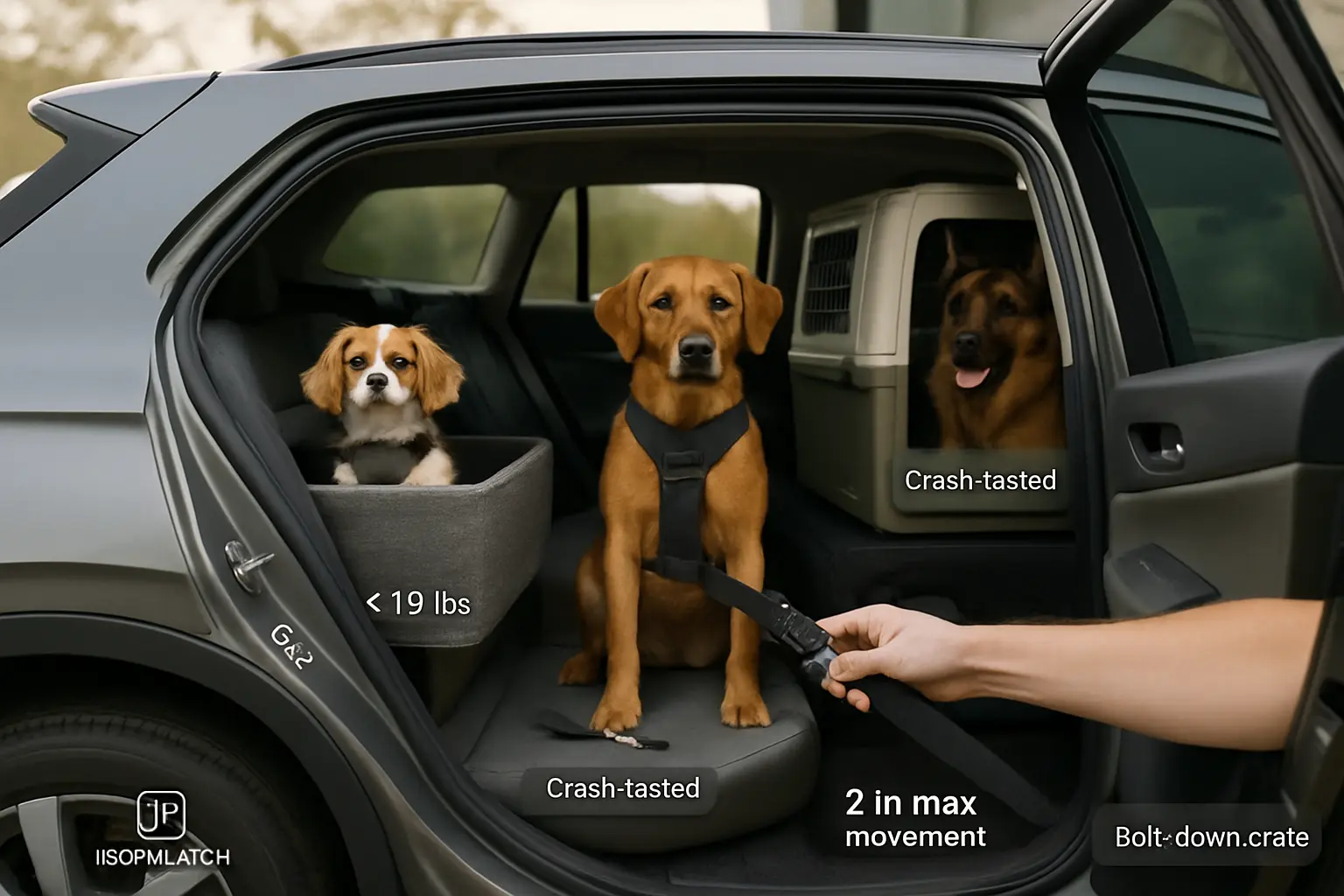
Choosing the right equipment starts with matching the dog’s size to the vehicle’s layout. Measure the dog standing and lying down. Note vehicle features: seat depth, trunk space, door opening width, and available anchor points. Select restraints and carriers that fit those measurements and allow air flow.
Prioritize items designed for vehicle use: crash-tested crates, harnesses rated for seatbelt anchors, and ISOFIX-compatible carriers where applicable. Consider how the item installs in a sedan, SUV, hatchback, or van. Installation that interferes with driver controls or sightlines creates a safety hazard.
Durability and maintenance matter. Choose materials that resist chewing, dry quickly, and clean easily. Non-slip bases and low centers of gravity reduce tipping. Test the chosen setup on short trips before long journeys.
For buying guidance and practical gear lists, see essential dog travel tips and gear for road trips. A quick CTA: measure both dog and vehicle and check the owner manual for anchor locations before purchase.
Solutions for small, medium and large breeds
Small breeds often travel best in booster seats or small crates that secure to the seat. These raise the dog for better visibility and reduce motion sickness. Choose a harness that clips to a seatbelt or a crate with built-in straps.
Medium breeds suit larger crates or back-seat harness systems. A well-fitted harness attached to a short tether keeps the dog low and centered. Crates should allow the dog to stand and turn comfortably.
Large breeds need robust solutions: heavy-duty crates, partitioned cargo setups, or vehicle ramps to avoid lifting. Crates for large dogs require strong tie-downs and a low step-over height. If using a harness, confirm the vehicle’s anchor points tolerate the dog’s mass.
For crate options and size guidance, consult the best dog crates for car travel. Always trial the solution with short drives to confirm comfort and stability.
What to look for: crash testing, ISOFIX/anchor compatibility and materials
Prioritize crash-tested restraints and carriers. Look for products independently evaluated by reputable labs or consumer testers. Crash-tested gear reduces the risk of failure in sudden stops.
ISOFIX and top-tether points provide secure mounting for compatible carriers. If a product claims ISOFIX compatibility, verify the vehicle’s anchor locations first. For harnesses, check that tethers attach directly to the vehicle’s structural anchors, not to grab handles or seat backs.
Assess materials: webbing should be strong and wide, buckles made of metal or impact-rated polymer, and zippers that resist bursting. Opt for foam or composite energy-absorbing elements in crates and seats. Removable, washable liners speed cleaning after accidents.
For practical anchoring techniques and retrofit ideas, see 5 ways to secure a dog crate in car. Always follow manufacturer installation instructions and recheck fastenings before each trip.
Protecting upholstery and cargo while keeping your dog secure
Protecting vehicle interiors requires a balance between containment and comfort. Use waterproof seat covers and heavy-duty cargo liners to guard against hair, dirt, and accidents. Non-slip mats under crates prevent shifting.
Hammock-style seat covers shield rear seats and create a barrier that reduces the chance of a dog falling into footwells or under pedals. For cargo areas, choose anchored crates or cargo barriers that mount to OEM points. These prevent forward movement during braking.
Combine protection with restraint: a crate or barrier plus a harness-tether prevents roaming and reduces damage in a collision. Choose breathable, abrasion-resistant fabrics to minimize wear. Regularly clean and inspect liners, straps, and anchor hardware for wear.
For cargo-specific setups and installation tips, consult how to secure a dog in the cargo area of SUV. A final CTA: test the full setup empty, then with the dog, before driving longer routes.
Practical health and comfort measures for trips
Drivers and pet owners should prioritize measures that protect a dog’s physical health and reduce stress during travel. Choose confinement and restraint options that fit the dog’s size and temperament, such as a properly sized crate or a crash-tested harness tethered to the vehicle’s anchor points. Secure the travel area to prevent sudden slides or tipping.
Plan for motion tolerance by conditioning the dog with short rides before longer trips. Keep routines familiar: the same bedding, a favorite toy, and a recent photo stored on the phone. Pack a compact travel kit with bottled water, a foldable bowl, waste bags, basic first-aid items and vaccination records. Monitor the dog visually and via mirrors or a camera system so the driver stays focused on the road.
Use breathable bedding and remove choking hazards from the travel space. For gear recommendations and packing checklists consult Essential dog travel tips and gear for road trips. Owners should also confirm local rules and airline or ferry requirements before departure.
Temperature control, ventilation and why windows should be partly closed
Maintaining a safe cabin temperature prevents heatstroke and hypothermia. Set the vehicle climate so the dog stays between roughly 60–75°F (15–24°C). Use the air-conditioning or heater on recirculate briefly to stabilize temperatures after doors open, then switch to fresh air for ventilation.
Windows should be partly closed to protect the dog. Slightly open windows provide airflow without allowing the dog to jump, fall out, or be hit by debris. Full-open windows increase the risk of accidental escape and can cause ear or eye injury. Use sunshades or tinted rear windows to reduce direct sun on a resting dog in the footwell or cargo area.
Watch for early signs of overheating: excessive panting, drooling, lethargy, uncoordinated movement. If those occur, stop immediately in a shaded spot, offer water, and cool the dog gradually. For puppy-specific enclosure alternatives and ventilation tips see How to transport a puppy in a car without a crate.
Feeding, hydration, motion-sickness prevention and calming strategies
Timing feeds reduces nausea: withhold a large meal for two to four hours before travel, but provide small sips of water up to departure. Offer hydrating breaks at stops, not while the vehicle moves. Use spill-proof bowls or travel bottles to limit mess and choking risk.
Treat motion sickness with gradual desensitization—start with short drives and increase duration. Consider veterinary advice for antiemetic medication or sedatives when necessary. Non-pharmaceutical strategies help: seated, forward-facing positions reduce vestibular conflict; a well-secured harness or crate stabilizes the dog and limits motion; pheromone sprays or anxiety wraps calm many dogs.
Distraction can work: a chew toy or long-lasting, vehicle-only treat provides positive association. For more detailed motion-sickness techniques and calming tips consult Make car rides enjoyable for your motion-sick pup. Always consult a veterinarian before using medications.
Regular stops, exercise breaks and ID/microchip checks
Schedule stops every 2–3 hours for bathroom breaks and exercise on long trips. Short leash walks help circulation and lower anxiety. Use a secure collar or harness and keep the dog leashed until in a safe, enclosed area.
Teach handlers safe lifting and transfer techniques for heavy or senior dogs to avoid injury during breaks. For guidance on helping large dogs enter and exit vehicles safely see 5 steps to safely lift a large dog into a car. During stops check the dog’s posture, paw pads, and breathing for signs of stress or injury.
Confirm ID before leaving: fasten a visible ID tag with current contact details and verify microchip registration and phone numbers. Carry a printed photo and vaccination certificate to speed reunification if the dog becomes lost. A quick pre-trip checklist saves time and reduces the risk of separation on the road.
If you’re stopped, fined or need to prove safety measures
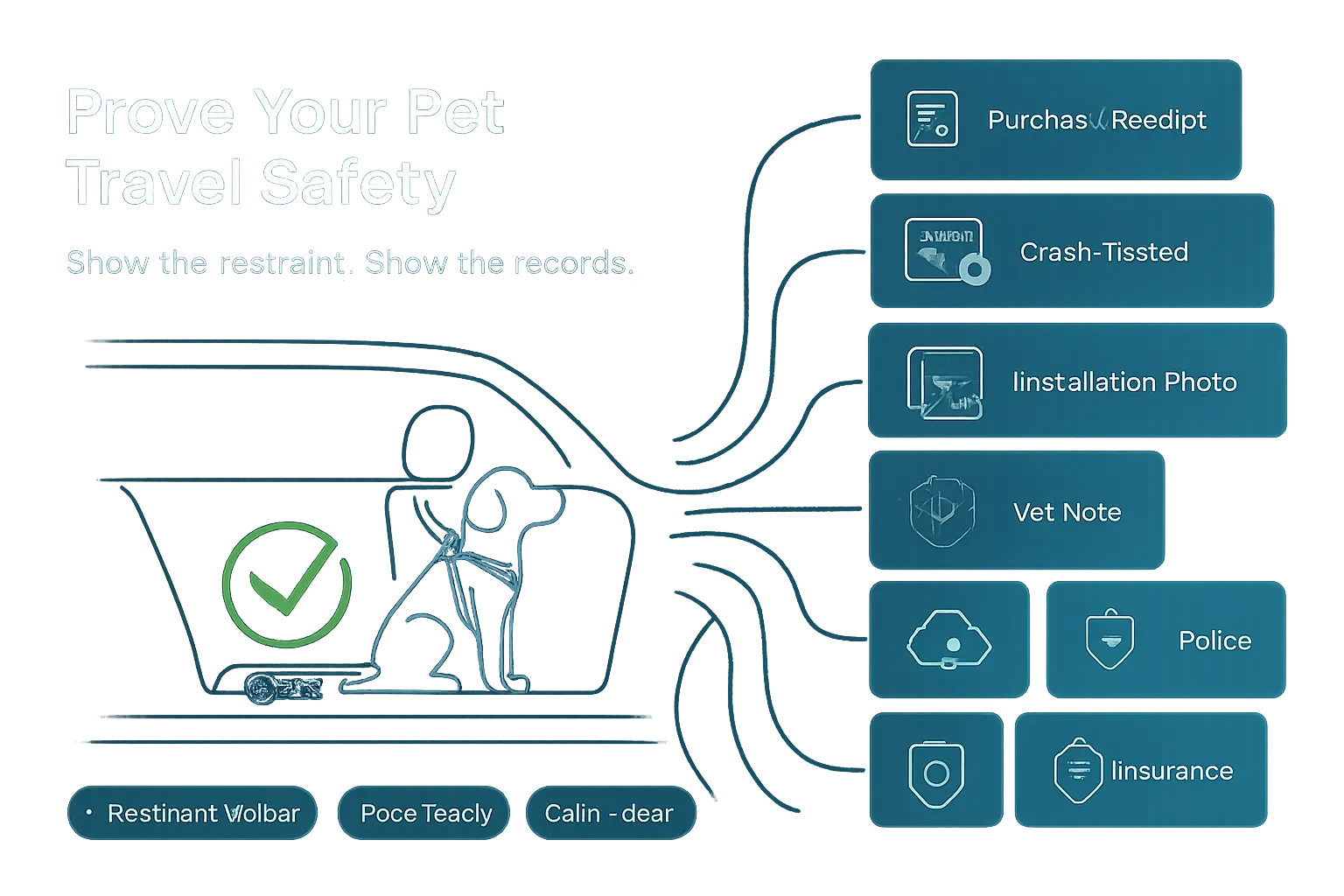
When an officer stops a driver for pet safety concerns, clarity and documentation reduce risk of fines. Remain calm, speak clearly, and state the restraint method used. Describe the device by name, its certified features, and why it meets safety needs.
What to show an officer and how to explain restraint choices
Offer visible proof first: the restraint itself, fitted to the dog. Demonstrate how it prevents movement and protects the animal in sudden stops. Explain selection based on dog size, behavior, and vehicle type. Mention any training or acclimation the dog received to travel safely.
Evidence to keep (purchase/fitment records, product specs, vet notes)
Keep a folder or digital file with receipts, installation photos, and the manufacturer’s specifications. Add vet notes if a medical condition requires special restraint. Warranty or crash-test info strengthens the case. For gear guidance, consult essential dog travel tips and gear for road trips.
How to contest a fine and where to check local rules
If fined, collect the officer’s citation details and witness names. Request bodycam or dashcam footage when applicable. Appeal using the citation number and submit your evidence promptly. Check municipal traffic codes and state vehicle-pet statutes online or at the local courthouse. A lawyer can advise if the fine persists. Keep digital backups of all documents and photos as a simple next step to protect against disputes.
Quick pre-drive checklist and concise FAQs about the footwell
Provide a practical pre-drive routine to reduce risk when a dog travels near the driver area. The checklist below covers restraint, placement, and environmental checks. Use the short FAQs to decide whether the footwell, lap, or front seat is appropriate for a specific trip. For step-by-step gear recommendations, see five ways to secure a dog crate in a car.
One-page safety checklist to follow before you drive
One-page safety checklist:
- Confirm a proper restraint: crash-tested harness, seat-belt tether, or secured crate.
- Never allow a dog to sit in the front footwell if the airbag can deploy.
- Install and test crate anchors or seatbelt clips; remove loose objects that can fly forward.
- Check ventilation and temperature; block direct sun on the dog.
- Keep water and a short leash accessible; schedule regular stops on long trips.
- Use non-slip bedding so the dog won’t slide under pedals or into corners.
- Attach ID and microchip info; bring vaccination or health papers for cross-border travel.
Short answers: Can a dog sit in the footwell / lap / front seat / windows open?
Footwell: Not recommended. The space offers no crash protection and can trap limbs. Lap: Unsafe and illegal in some places because it distracts the driver. Front seat: Risky if an airbag deploys. Keep dogs restrained in the rear. Windows open: Slightly safer for airflow but increases the risk of ejection, jumping, or debris injury. Use a secured harness or crate and keep windows only partially open.
When to ask a vet, trainer or retailer for tailored advice
Consult a vet for motion sickness, pregnancy, breathing problems, or sedative advice. Ask a trainer for behavioral solutions if the dog panics, barks, or tries to escape restraints. Visit a retailer to confirm harness fit, crate size, and vehicle-specific anchor methods. If uncertainty remains about a dog’s tolerance for travel, request a professional assessment before a long trip. For immediate help, schedule a vet or trainer consultation and verify gear compatibility with the vehicle.
Summary
Dogs should not travel in a car footwell. While many laws do not name the footwell directly, they impose a clear duty to restrain animals so they cannot distract the driver or interfere with controls. A dog in the footwell increases crash risk, invites enforcement action, and exposes both animal and passengers to serious hazards from pedals, intrusion, and airbag deployment.
Safer, compliant options include a crash-tested harness attached to a rear-seat belt or ISOFIX/LATCH point, or a properly sized, well-anchored crate in the cargo area. The guide outlines step-by-step setup, equipment selection by dog size, installation checks, training for calm travel, and what to show officers or insurers if stopped or after an incident. Choosing tested restraints, securing anchors correctly, and documenting measures reduce legal, safety, and insurance risks.
Key Takeaways
- Legal duty: Most jurisdictions require “reasonable restraint” that prevents a dog from distracting the driver or obstructing pedals and controls.
- Footwell risks: Pedal interference, crush-zone exposure, entrapment, and airbag impact make the footwell a high-danger area, even at low speeds.
- Safer placements: Use a crash-tested harness on the rear seat or a secured crate in the cargo area; avoid the front seat if airbags are active.
- Correct setup: Anchor to seatbelts or ISOFIX/LATCH, keep tethers short, remove loose items, ensure ventilation, and verify less than two inches of movement.
- Training and welfare: Acclimate with short practice trips, use familiar bedding and safe chews, plan stops every 2–3 hours, and manage temperature and hydration.
- Documentation: Keep receipts, product specs, install photos, and vet notes to demonstrate compliance during traffic stops or insurance claims.
FAQ
-
What do laws say about dogs in the footwell?
Most rules don’t name the footwell, but they require restraint that prevents distraction and interference. A dog in the footwell often fails that standard and may lead to warnings, fines, or liability after a crash. -
Why is the footwell unsafe for a dog?
It sits in the crush zone, near pedals and airbag deployment, increasing the risk of blunt-force trauma, entrapment, and driver distraction. -
How should a dog be restrained to comply with Rule 57–style duties?
Use a crash-tested harness attached to a seatbelt or ISOFIX/LATCH, or a properly sized crate anchored to factory tie-downs. Treat guards and hammocks as supplements, not primary restraints. -
What’s the safest place for a dog during car travel?
The rear seat with a crash-tested harness or a secured crate on the flat cargo floor. Avoid the front seat if airbags are active. -
How can drivers prove safety measures if stopped or after an incident?
Show the fitted restraint, explain anchor points and sizing, and provide receipts, manufacturer specs, and installation photos. These records help with both enforcement and insurance reviews.


